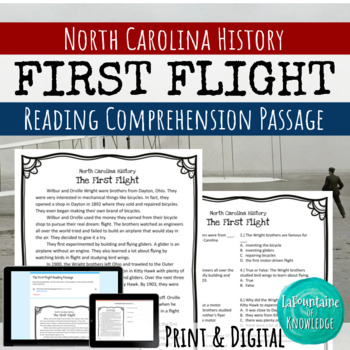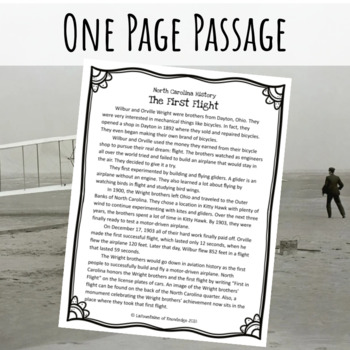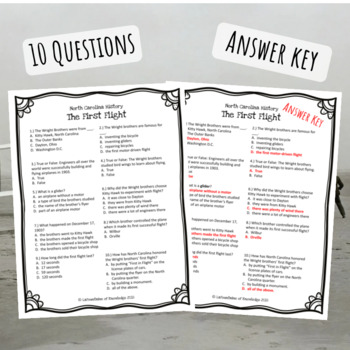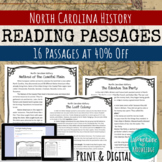The Wright Brother's First Flight Reading Comprehension Passage PRINT & DIGITAL
- PDF
- Google Apps™
- Easel Assessment

What educators are saying
Also included in
- This North Carolina history reading comprehension bundle includes 16 easy to read one page passages! Each passage comes with 10 multiple choice reading comprehension questions, an answer key, and 2 self-scoring digital versions - EASEL and Google Forms. Passages include:Three passages about NC NativPrice $25.20Original Price $42.00Save $16.80
Description
This easy to read passage details the story of Wilbur and Orville Wright's first successful flight of a motor-driven airplane on December 17, 1903 in Kitty Hawk, North Carolina. It explains the Wright brothers':
- background repairing bicycles in Dayton, Ohio
- experiments building gliders and studying birds to learn about flight
- time spend in Kitty Hawk preparing and testing their plane
- legacy in North Carolina and how they are honored on NC license plates, the NC quarter, and with a monument at the site of their first flight
The passage includes 10 multiple choice reading comprehension questions, an answer key, and 2 self-scoring digital versions - EASEL and Google Forms.
If you like this passage, be sure to check out the other North Carolina History reading passages in this collection or buy the bundle and save 40%!
Please follow my store here for more great resources!
You can also find me on Facebook, Instagram, and lafountaineofknowledge.com where you'll discover ideas, inspiration, and plenty of freebies! Or join my email list to get my monthly newsletter with exclusive FREE resources you can't get anywhere else!
Want free money to spend on Teachers Pay Teachers? Rate this product to earn some TpT credit! Leaving feedback helps us both out and takes less than a minute! Your support makes it possible for me to continue making and sharing great resources! Thank you!
Credits: Border by Chirp Graphics, used with permission. Cover photograph by John T. Daniels 1903, sourced from WikiImages via Pixabay and used with permission. Fonts include: Love Ya Like A Sister by Kimberly Geswein, Special Elite by Astigmatic, Calibri by Luc de Groot, and Amatic SC by Vernon Adams. All fonts used with permission under open source licenses.







